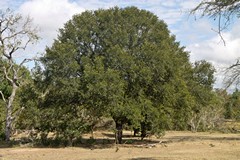As an ex-Game Ranger and now a safari guide, I belief in educating people about our beautiful African world. There is so much more to experience than just the 'Big 5'. From this, the "Trees of Africa' series of geocaches was born.
The Jackalberry (Diospyros mespiliformis), also known as African ebony, is a large deciduous African tree found mostly from Senegal and the Sudan right down to Namibia and the Northern Transvaal. The tree is part of the Ebenaceae family. It commonly grows on savannahs or in savannah woodlands, and on islands and the edges of the Okavango Delta. Jackals are fond of the fruits, which explains its common name.
The tree prefers moist soil, and rocky soils. It grows well in red loams, volcanic and loamy sands. jackalberry trees are also commonly found along river beds. It often grows on termite mounds. In heavy soils the termite mounds provide the tree with aerated soil, and a source of moisture. The roots provide protection for the termites, who don't eat the living wood. Jackalberry wood is almost termite-resistant after it has been cut down.
The jackalberry tree can grow up to 25 metres, with a trunk circumference of 5 metres. However, heights of 6 metres are more usual. They have a rounded crown, which is densely foliated. The mature trunks from older and heavier trees have fluted, flattened ridges along the trunk which buttress and strengthen them. The bark is dark brown when young, turning dark grey as it matures and has a rough texture, forming deep longitudinal fissures.
Leaves are elliptical in shape, up to 15cm long and 7 cm wide with smooth or wavy edges. Older leaves are more glossy, and have a leathery look, darker green above and a lighter green below. Young leaves and twigs are covered with downy hairs. Young trees are evergreen, but older ones will shed their leaves in Spring. New leaves will grow from June to October and can be pinkish, orange or reddish in color. The leaves are eaten by elephants, rhinos, giraffes, buffalos, and kudus. The larvae of the bushveld emperor butterfly also eat the leaves of this tree.
The skin of the fruit is tough but it is edible by people. Fruits have a floury consistency with a lemony flavor. They can be eaten fresh or preserved. They are also dried and ground into flour. A beer and a type of brandy is also brewed from them.
Wood is hard, and very strong, and almost completely resistant against termites. In the Delta the trunks are used to make canoes (makoros).